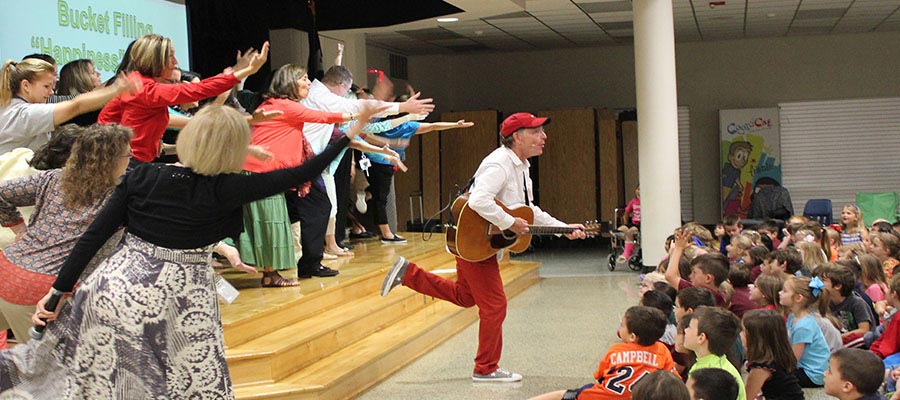Materials Needed
1. A box of instant mash potatoes.
2. A gravy bowl or gravy ladle.
3. Three white poster boards that when cut into quarters you get 12 (14” x 11”) boards. You will need 11 of the (14” x 11”) boards.
4. The song, Gratitude, from Red Grammer's recording, Bebop Your Best.
5. Markers, a hole punch and yarn.
Teacher Preparation
1. At the end of the song, Gratitude, Red and children sing the word thank you in different languages (see list below). Write each thank you on the white board with one color marker (one on each board). Write the country origin underneath in a different color marker:
Thank you ( English)
Gracias (Spanish)
Danke (German)
Merci Beaucoup (French)
Arigato (Japanese)
Komawoyo (Korean)
Shukran (Arabic)
Salamat (Tagalog – Philippines)
Ngiyabonga ( Ndebele- Zimbabwe)
Kia Ora (Maori – New Zealand/Australia)
Thanks a lot
2. After writing the words on the white boards turn the board over and punch 2 holes (one on each end) at the bottom of the board. Put enough string through the holes so that the board will fit over a student’s head. Each student will be wearing one sign but it will hang on them backwards and upside down (in other words you can't read the sign while it is hanging on the front of the student). When it comes time in the song to show their sign the student will flip it up so that everyone can see what is written on the sign. The reason for a sign on each student is so that their hands are free to participate in the movements for the song and each student can easily raise the sign up when it is time.
3. When it is time for the students to actually sing the song to a visitor in your classroom, either have the CD queued to the last part of the song where the “thanks you” in different languages are sung or tape that part of the song and have it ready on a cassette.
Activity
This activity is designed to have students show gratitude to visitors that come to your classroom. If you have room mothers come in or a special reader for your class the students can thank them in a very special way. This lesson is set up for 10 students. You can easily adjust it to the number of students in your room by just adding more thank you signs.
1. The 10 students line up in two rows of 5 facing each other. The student at the front of line A has a box of instant mash potatoes in his/her hand and is closest to the guest in line A. The student in front of line B has a gravy boat or ladle in his/her hand and is closest to the guest. The signs are around their necks with the words facing away so that they cannot be seen. With the very young students it does not matter if the signs are in the same order that the thank you’s are sung on the recording. With older students you might want to put them in order. You will understand what order to put them in as you proceed through the steps to this lesson.
2. As the children sing, “If you pass me the mash potatoes”, line A sways away from the guest and stops on the word “me” then swings or sways toward the guest and stops on the word "potatoes”. The student with the box of potatoes hands it to the guest. Line B is standing still through this part but is singing along with line A.
3. As the children sing, “and remember to put the gravy on the side”, line B turns away from the guest (it doesn't matter how many times they spin or turn) with their hands over their heads. They spin away from the guest until the word “gravy” then spin toward the guest until the word “side”. On the word side everyone in line B motions with one hand like they are pouring gravy and the student with the gravy boat or ladle hands it to the guest. Line A is standing still but singing along with Line B.
4. As the children sing, “I’m so grateful, so incredible grateful” Line A and Line B are facing each other one on one and they shake hands first with their right hands and, still holding the right hands, extend their left hands and shake hands. Their arms should be in a crisscross as they are shaking hands.
5. As the children sing, “Thank you, thank you, thank you”, they face partners for the first Thank you and say thank you in sign language; they face anyone else in the line for the 2nd thank you and say thank you in sign language; they face the guest for the last thank you and say thank you in sign language. NOTE: The sign language for thank you is: right hand is open and finger tips are touching your chin. left hand is open and away from the chin about a foot or so. The right hand moves away from chin and gentle drops and hits the left hand.
6. Now turn on the queued music for the thank you signs. It first starts by playing marching music. The 2 students at the front of the line march in place (these are the students that handed the guest the ladle and box of potatoes). The other students march so that last student in each row comes forward and others follow so that they are now all in one straight line facing the guest. As the “thank you's” are being sung the students hold up their signs one by one all the way down the line. This is quick so younger students may not be able to sing with the recording and their signs may not be in the exact order but it doesn’t matter. The guest will see all the thank you cards and understand that the students have sung "thank you" in different languages.
Extension
1. You could have the students write the words “Thank you” and sign them on a small piece of paper. The notes could be put in the gravy boat so the guest will be able to have them. But be careful that the student “pouring” with the gravy boat during the song doesn’t tip it too much or they will dump out.
2. You could add a thank you treat to the gravy bowl for the guest to take with them.
3. This activity could be done at the end of a spring/winter concert, Mother’s Day, Grandparent's Day etc.



